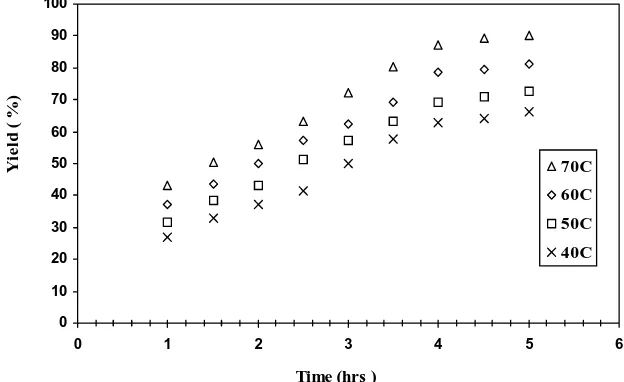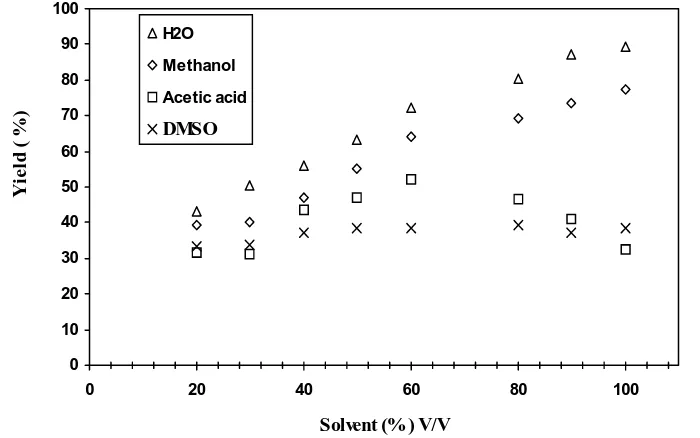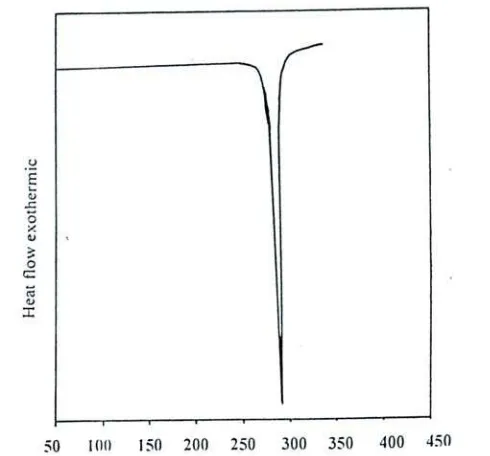1. Introduction
Clays are laminar phyllosilicates that represent a low-cost, accessible alternative for catalytic sup-ports, which are susceptible of being modified for obtaining improved properties. The reactions cata-lyzed by clays are carried out under mild condi-tions, the work up procedure is simple as the sepa-ration of the spent catalyst is achieved by filtra-tion, and the product is recovered by mere evapora-tion of solvent. Further, the clays catalysts can be regenerated easily and reused. In particular, the microporous structure and surface acidity of those materials is of great interest for carrying out reac-tions such as catalytic cracking [1-2], esterification [3], alkylation [4-5], nitration [6], dehydration [7-8], and polymerization catalysis [9-11]. These ca-talysis have found use in industrial processes such as alkylation of phenols and dimerization and po-lymerization of unsaturated hydrocarbons[12].
The present papers examines the ability of
Catalytic polymerization of Acrylonitrile by Khulays Bentonite
M.M. Al-Esaimi
Umm Al Qura University , Faculty of Applied Science, Chemistry, Department, Makkah Al- Mukarramah , P.O. Box 4496 , Saudi Arabia, E-mail: [email protected]
* Corresponding Author. Telp. (024)7460058, Fax. (024)76480675 E-mail address: [email protected] (Istadi)
Bulletin of Chemical Reaction Engineering & Catalysis, 2(1), 2007, 6-10
Received: 5 February 2007; Received in revised: 19 April 2007; Accepted: 7 May 2007
Abstract
The aqueous polymerization of acrylonitrile (AN) catalyzed with exchanged Khulays bentonite . The influ-ence of various polymerization parameters ( e.g., concentrations of Potassium Persulfate (K2S2O8) and
monomer , various of organic solvents, and different temperature has been investigated. It was found that the rate of polymerization of AN was found to be dependent on monomer concentration ,initiator and temperature. The activation energy of polymerization was calculated .Thermal properties of the polymer were studied by TGA and DSC techniques. © 2007 CREC UNDIP. All rights reserved.
.
Keywords: bentonite, catalyst, acrylonitrile, polymerization, bentonite
treated Khulays Bentonite clays to catalyze po-lymerization of acrylonitrile (AN). The rate polym-erization by using different concentrations of K2S2O8 initiator and monomer, various of organic
solvents, and different temperature were stud-ied.Thermal analyses of the resultant product after polymerization have been performed by Thermo-gravimetry (TG) and differential scanning calo-rimetry (DSC). The monomer of acrlyonitrile was selected because its copolymers with others poly-mers have wide industrial applications in surface coatings technology [13], hemodialysis [14], ul-trafiltration [15], enzymeimmobilization [16] , and pervaporation[17] .
2. Materials and Methods
Acrylonitrile (AN) (BDH chemicals, LTD ,England) stabilized with 0.1 % Hydroquinone, was washed with Sodium hydroxide solution to remove inhibitor. The crude AN monomer was degassed
and twice distilled on a vacuum line, dried over anhydrous Na2SO4 and stored below -18 0C.
The Khulays bentonite was kindly supply by Saudi Geological Survey (SGS) (Saudi Arabia, Jeddah). Exchanged treated clay was prepared [10] by ion-exchanged method using solutions of Al(SO4)3.16H2O. The exchanged clay was
repeat-edly washed and centrifuged before drying in a oven at 60 0C for several days. It was then
ground and sieved at 106 mesh (ASTM). The ma-terial was then stored in a dry-air container.
Potassium persulphate (K2S2O8), methanol,
acetic acid and DMSO were products of BDH chemicals LTD. .
2.1. Thermal Analysis
Thermogravimetry (TG) was recorded for poly-mer using Mettler 3000 TA thermobalance. The sample (about 10 mg) at heating rate of 10 0C
/min in air media. The TGA experiment was taken over a temperature range 30–800 0C.
Differential scanning calorimetry (DSC). Analysis was conducted by a DSC-30 unit of the Mettler TA-3000 system. The DSC analysis at a heating rate of 10 0C /min from 50 to 500 0C; plot
10 cm; and full-scale range, 25 mW .
2.2. Polymerization of acrylonitrile (AN) in presence of treated Khulays bentonite
The polymerization experiments were placed in the reaction vessel containing known concentrations of initiator and the monomer acrylonitrile (AN). The exchanged Khulays bentonite was added and then the flask was well stoppered and and maintained at the desired temperature by a thermostat. The requisite
amount of the initiator solution was carefully added to the reaction mixture. The reaction was stopped by keeping the flask in ice-cold water and by addition of a known excess of hydroquinone, which spontaneously consumed the unreacted free radicals. The precipitated polymers were filtered and purified by washing repeatedly with distilled water and absolute alcohol. Then they were dried till a constant weight at about 60 0C.
The percentage conversation was determined gravimetrically.
3. Results and Discussion 3.1. Catalytic Studies
3.1.1. The effect of time on polymerization The effect of polymerization temperature is illustrated in Figs. 1, keeping the concentrations of AN, K2S2O8 and catalyst weight constant at
1.518, 0.03 mol.dm-3 and 0.5 g, respectively The
polymerization conversion increased sharply in-crease in the polymerization temperature from 40 to 70 0C in the conversion in the first step of the
polymerization process. After that sharp increase there is an additional moderate increase in the conversion. Finally, there is no further change, indicating the end of the polymerization process which may be due to chain termination processes predominate, leading to deactivation of the cata-lyst. Similar general behavior of the polymeriza-tion efficiency as a funcpolymeriza-tion of time was previ-ously reported [18-20].
3.1.2. The effect of monomer concentration The effect of monomer concentration in the polymerization was investigated in the range (1.137- 4.171 mol.dm-3) at a fixed concentration of
Bulletin of Chemical Reaction Engineering & Catalysis, 2(1), 2007, 7
0 10 20 30 40 50 60 70 80 90 100
0 1 2 3 4 5 6
Time (hrs )
Yi
e
ld
(
%
)
70C 60C 50C 40C
the other reagents at 60 0C. The results obtained
are shown in (Table 1). With increase in monomer concentration up to 2.645 mol.dm-3, the
conver-sion increase and then decrease. As can be ex-pected, increasing the AN concentration may in-crease the polymerization rate, and thus inin-crease the precipitation rate of the oligomeric chains. The decrease of conversion may be due to an in-crease in the viscosity of the medium and a conse-quent decrease in the mobility of propagating spe-cies [21-22] .
3.1.3. Effect of K2S2O8 concentration
The effects the conversion have been stud-ied by varying the concentration of the initiator in the range 0.01-0.04 mol.dm-3 by keeping the
con-centrations of the other reagents fixed at 60 0C.
as given in Table 1. With the increase in K2S2O8
concentration in the above range the conversion were found to increase due to an increase in con-centration of the active species [23] resulting in smaller oligomers with higher critical micelle con-centration (CMC). Increasing the initiator concen-tration causes an increase in the oligomeric radi-cals’ concentration, and thus in the number of PAN chains. This may lead to an increase in the number of PAN (more nuclei) and an increase (more PAN chains participating in the growing process). Moreover, a higher initiator concentra-tion increases the growth rate of the oligomeric chains [24-25] . Initiator by using the concentra-tions of AN, K2S2O8 and catalyst weight constant
at 1.518, 0.03 mol.dm-3 and 0.5 g at 60 0C. The
reaction was carried out in various solvents like water ,methanol, acetic acid and DMSO. The re-sults obtained in the order: water >methanol >acetic acid> DMSO. The results were shown in (Fig. 2). It was found that the [DMSO] has no ef-fect on the rate of polymerization. The retardation by the solvents may by due to: (i) the oxidation of the additives by K2S2O8, thus reducing the
opti-mum concentration of the initiating radicals in the immediate vicinity of the monomer, (ii) the premature termination resulting from activity transfer to these solvents [26-27] .
3.1.4. Activation Energy of polymerization Apparent activation energy, Ea was calcu-lated from initial rate of polymerization of AN with treated clay, at 55, 60, 65 and 70 0C. Plots of
ln K vs. 1/T were made so the activation ener-gies could be determined by using Arrhenius Bulletin of Chemical Reaction Engineering & Catalysis, 2(1), 2007, 8
Table 1. The effect of concentration of AN, K2S2O8 and bentonite weight on the conversion of
polymerization of acrylonitrile at 60 0C for 3h.
Conversion
relationship. Table (2) represents the activation energy of polymerization of AN.
3.2. Thermal study of PAN
Figure 3 represents the TG and DTG curve for the polyacrylonitrile (PAN). The DTG analysis shows three steps thermal degradation processes, the first step weight loss occurs in the tempera-ture range 73–182 0C with a mass loss of 8.25 %
which is due to expulsion of loosely bounded wa-ter molecule from the polymer chain [28-29].The second step weight loss occurs in the temperature range 220–309 0C with a weight loss of 7.7%
which can be attributed to the loss of oligomers. The third and final step weight loss occurs in the temperature range 317–582 0C with a mass loss
of 60.5 %. Followed by degradation at higher tem-perature the strong dipole-dipole interaction be-tween the polymer networks may be the prime reason for higher thermal stability of PAN [30]. The total weight loss in air up to 800 0C about
90%. DSC curve is shown in Figure 2 .The DSC thermograms show that AN polymer exhibits a sharp exothermic cyclization peak at 288 0C .This
exothermic is related to the cyclization reaction of nitrile groups [31].
4. Conclusions
The khulays bentonite catalyzed aqueous polymerization of acrylonitrile (AN) has been significantly carried out and factors affecting the polymerization have been investigated. The advantages of using this catalyst are: (i) use of cheap and easily available catalyst, (ii) requirement of small amount of catalyst, (iii) short reaction times, (iv) high product yields. Thermal properties of the polymer were studied by TGA and DSC techniques.
Acknowledgment
The author is grateful to Saudi Geological Survey (SGS) (Saudi Arabia, Jeddah) for supplying Khulays Bentonite clay which used as catalysis in this study.
References
[1] Milliken, T.K, Miles, G.A, and Oblad. A.D.,
Trans.,Faraday Soc., 8, 50, 279. [2] Pinnavaia, T.J. , Tzou, M.S. , Landau, S.D. ,
Raythatha, R.H. , J. Mol. Catal. 27 (1984) 195. [3] Yoo, J.W., Lee, C.W., Jeong, H.-C. , Park, Y.-K. , Park, S.-E. , Catal. Today, 60 (2000) 255. [4] Choudary, B.M. , Kantam, M.L., Sateesh, M. ,
Rao, K.K. , Santhi, P.L., Appl. Catal. A: Gen. , 149 (1997) 257.
[5] Inui, K. , Kurabayashi, T., Sato,S., Ichikawa, N., J. Mol Catal. A , 216 (2006), 147.
[6] Laszlo, P., and Mathy, A., Hev.Chim.Acta, 70, 1987, 577.
Bulletin of Chemical Reaction Engineering & Catalysis, 2(1), 2007, 9
Table 2. Activation Energies of Polymerization of acrylonitrile with AN.
K2S2O8 Activation Energies Ea (kJ/mol)
concentration (mol/l)
ANC only ANC
+Bentonite
0.01 42.5 37.3
0.02 35.4 31.1
0.03 28.3 22.1
0.04 24.2 17.3
Figure 3. TGA and DTGA thermogram of poly-acrylonitrile (PAN)
[7] Vinu, A., Ariga, K., Devassy, B.M., M.
Hart-mann, Halligudi, S.B., Micropor. Mesopor. Mater. 80 (2005) 195.
[8] Al-Esaimi, M.M., Inter Jour. Chem., 16, 2006, 75.
[9] Cornelis, A., Laszlo, P, and Pennelneau, P., Bull. Soc. Chim, BELG., 961, 1987, 29.
[10] Al-Esaimi, M.M., J. Appl. Polym. Sci., 64, 1997, 367.
[11] Breen, C., Zahoor, F., Madejova, D., Ko-madel, P.J., J. Phys. Chem. B, 101, 1997, 5324.
[12] Eliseeva VI. Emulsion polymerization and its application in industry. New York : C Bu-reau, 1981.
[13] Kotkar, D., Ghosh, P.K., J. Chem. Soc. Chem. Commun., 950, 1986.
[14](a) Lin WC, Liu TY, Yang MC. Biomaterials, 25, 2004, 1947.
(b) Clark WR, Gao D, Ronco C. In: Ronco C, La Greca G, editors., Hemodialysis technol-ogy. Basel: Karger Publisher; 2002. p. 70. [15](a) Ulbricht M, Richau K, Kamusewitz
H.,Colloid Surf ,A,138,1998, 353.
(b) Musale DA, Kulkarni SS. J Membr Sci 1997, 13,136.
(c) Qin JJ, Cao YM, Li YQ, Li Y, Oo MH, Lee H. Sep Purif .Technol, 36, 2004, 149.
(d) Jung B. J Membr. Sci, 129, 2004,229.
(e) Yang MC, Liu TY. J Membr. Sci., 119,2003,226.
[16] (a) Ulbricht M, Papra A. Enzyme Mi-crob .Technol, 199761.
(b) Godjevargova T, Konsulov V, Dimov A. J Membr. Sci,152,1999,235.
(c) Godjevargova T, Dimov A, Vassileva N. J Membr. Sci, 116, 1996,273
[17](a) Bhat AA, Pangarkar VG. J Membr. Sci, 167, 2000, 187.
(b) Mandal S, Pangarkar VG. Sep Pu-rif .Technol, 30, 2003,147.
[18] Shen,S., Sudol,E.D., El-Aasser,M.S., J. Po-lym. Sci. PoPo-lym. Chem. 31,
[19] Liu, J., Chew, C.H., Wong, S.Y., Gan, L.M. , Lin, J. ,Tan, K.L. , Polymer 39 (1998) 283. [20] Capek, I. , Macromol. Chem. Phys. 195 (1994)
1137.
[21] Christian, P., Giles, M.R., Griffiths, R.M.T.,Irvine, D.J., Major, , D.J., S.M. Howdle, Macromolecules 33 (2000) 9222.
[22] Shen,S., Sudol, E.D., El-Aasser, M.S., J. Po-lym. Sci. PoPo-lym. Chem. 30 (1992) 2765.
[23] Beharai,K.,Bahadur,L.,Agarwal,U., J. Am. Chem. Soc., (Polym.Div.) Polym.Prep., 35,1994, (1)117.
[24] Capek, I., Le Quang, T. , Makromol. Chem. 187 (1986) 2063.
[25] Candau,F., Ottewill,.H.,R "An Introduction to Polymer Colloids", Kluwer Academic, Dordrecht, 1990.
[26] Wang YM, Feng LX, Pan CY. J Appl Polym Sci,70,1998,2307.
[27] Huang X, Brittain WJ. Macromolecules , 34,2001, 3255.
[28] Khor,S.H., Neoh,K.G., Kang,E.T., J. Appl. Polym. Sci., 40, (1990), 2015.
[29] Yue,J., Epstein,A.J., Zhong,Z., Galla-gher,P.K., Mac Diarmid,A.G.,
[30] Freshour,G.B., in: Masson,J.C. (Ed.), "Acrylic Fibre Technology and Applications", vol. 1, Marcel Dekker, New York, 1995, Chapter 7, p. 197.
[31] Lin W, Hsieh YL, Warganich D, Zhou WJ, Kurth MJ, Krochta M., Polymer, 39, 1998,4911.


